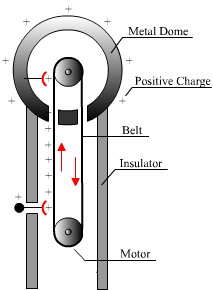High Energy Radiation Systems
After reading this section you will be able to do the following:
- Describe different ways that radiation can be generated.
As we mentioned before, there are many different ways that radiation can be generated. We have looked closely at two of the most widely utilized sources, radioisotopes and x-ray generation. We will briefly introduce a few other means of generating radiation. These methods are often referred to as the high energy radiation systems.
Some of our greatest scientific developments include high energy particle accelerators. Many of the natural and artificial radioisotopes along with standard X-ray systems are limited in terms of energy. Much of the scientific research dedicated to subatomic nature would not be possible without particle accelerators.
The Electrostatic Generator
An American physicist, R. J. Van de Graaff, developed one of the first particle accelerators in the early 1930's, which is known as the Van de Graaff generator, electrostatic generator. This device accelerates electrons to produce high energy radiation. Initially, the generator was capable of producing X-radiation in the 1 to 2 MeV range. Continued design changes produced even higher energies.

The generator operates by projecting electrons onto a moving belt. The electrons ride on the belt and are collected at the opposite end on a high voltage terminal. Here, a heated filament supplies electrons for acceleration. A glass/metal tube with a vacuum provides a path for particle acceleration away from the high voltage terminal. At the end of the tube is a target, whereby the accelerated particles can interact producing high energy radiation.
Not long after the development of the Van de Graaff generator, it was determined that charged particles could be accelerated to very high speeds by driving them in a circular path. This was accomplished by the application of strong electromagnets. A variety of these have been developed to produce even higher energy radiation than that of the Van de Graaff generator.
The Cyclotron
Again in the early 1930's, E.O. Lawrence who was also an American physicist developed the Cyclotron. This device is capable of accelerating charged particles (protons) in a circular path to energies that exceed 10 MeV. The Cyclotron is comprised of a large cylindrical box sandwiched between the poles of an electromagnet. The box is evacuated until a high vacuum exists. Charged particles are fed into the cylindrical box. Two D-shaped electrodes placed back to back with a gap between them are connected to a high voltage source inside of the box. By rapidly reversing the electric charge on the electrodes, and due to the presence of the magnetic field of the electromagnets, the charged particles move in a circular fashion. Each time the charged particles cross the gap of the electrodes, the particles gain energy and begin moving towards the outside of the cylindrical box. Once the charged particles reach the outer edge of the box, they are deflected towards the target, resulting in high energy X-radiation.

The Betatron
Another interesting accelerator, known as the Betatron, was developed in the early 1940's by a man name Donald Kerst at the University of Illinois. Kerst's Betatron is used to accelerate electrons (beta particles) to produce high energy x-radiation. The first Betatron developed produced a radiation energy of a little more than 2 MeV. Continued development allowed the Betatron to generate energies as high as 300 MeV.
The Betatron operates on the principle of the transformer. The primary side consists of a large electromagnet, and the secondary side is the electron stream that is being accelerated. The electrons are accelerated in a circular tube known as a doughnut that has been evacuated. When the electrons have achieved maximum energy, they are directed to a target, the resulting interaction is the production of high energy X-rays.
Linear Accelerator
A particle accelerator, different from those previously mentioned, is the Linear accelerator, designed to move charged particles at high velocities along a straight path to a target. Linear accelerators are comprised of a series of drift tubes mounted inside of an evacuated chamber. The charged particles are fed into one end of the chamber, and accelerated by a alternating high frequency voltage that is applied to the drift tubes. Due to high frequency, the drift tubes alternate charges, resulting in repulsion of the particles as they leave a tube, and attraction by the next tube. It is this alternating high frequency that accelerates the particles as they cross the gaps between tubes.

Linac (linear accelerator) as CERN
Present day Linear accelerators may be several miles long, capable of producing extremely high energy X-rays.
The previously mentioned particle accelerators are only a small sample of the high energy radiation capabilities utilized today. Many of these systems were developed to benefit the medical field, research in the science field, and the industrial examination of very thick or heavy wall materials. If you are interested in learning more about high energy radiation sources, there are numerous sources available in both written form and on the Internet.
Review:
- Radioisotopes, x-ray generation, and particle accelerators are different methods that generate radiation.